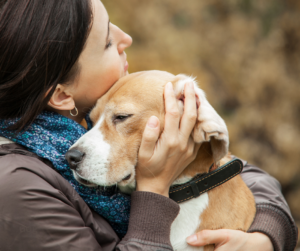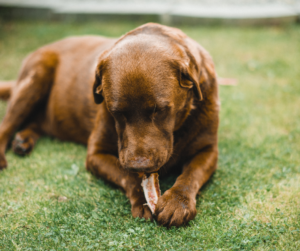Michael Baugh CDBC CPDT-KSA
I am in the business of dogs who make poor behavior choices. They are the ones who growl and snarl and bite. It’s easy to forget that our dogs are more than a list of problem behaviors to solve. We humans focus on what is threatening or what we perceive as threatening. It’s one of our faults.
You’ve heard the story a million times. You might have even read it in one of my blogs. It’s the one about how ancient humans needed to be on guard for trouble. Our minds and our bodies developed to identify and escape danger. Think: saber-tooth tiger. Now we modern humans struggle with the legacy of our own evolution. Our adrenal glands get fired up over an email. We are constantly on edge. And there isn’t a saber-tooth anything in sight.
Then, one day, for some reason or other, our dog growls. Our ancient brain reacts. He’s the same dog we watched TV with last night. He does the same cute tricks. We love him. But he growled. What if he bites? This is what we humans were built for. Identify a threat. Escape or dispatch it. Our dog isn’t our dog anymore. He is our aggressive dog.
 I am in the business of dogs. Our dogs (yes, that includes yours) are more than their occasional frightening misbehavior. We can address the growling, snarling, and biting. And we will, of course. Those behaviors, however, are not who your dog is. Most of the time our dogs behave delightfully. They cuddle up in front of the TV with us. They do tricks. We love them and they love us back. Our bad dogs are truly good in all the ways we’d hoped for — most of the time. They are so much more than a list of problems behaviors to solve — most of the time. And yet, we can’t seem to appreciate that. The problem is us — you guessed it — most of the time.
I am in the business of dogs. Our dogs (yes, that includes yours) are more than their occasional frightening misbehavior. We can address the growling, snarling, and biting. And we will, of course. Those behaviors, however, are not who your dog is. Most of the time our dogs behave delightfully. They cuddle up in front of the TV with us. They do tricks. We love them and they love us back. Our bad dogs are truly good in all the ways we’d hoped for — most of the time. They are so much more than a list of problems behaviors to solve — most of the time. And yet, we can’t seem to appreciate that. The problem is us — you guessed it — most of the time.
We humans are not naturally inclined to see what is going well. Our ancestors didn’t ponder the blissful absence of deadly predators (the ones who did got eaten). We don’t come home and tell our spouses about all the cooperative and productive emails we exchanged. No one appreciates how cool it is that a thousand vehicles are barreling down the highway and none of them are hitting each other. And most of us miss how great our dog is on any given day.
Our nature is to look for trouble. We have to learn to look for the good. It’s a learned skill. It takes practice.
Think for the moment about all the non-violent, non-annoying things your dog does. Better yet, think about the cute things. What does your dog to that makes you smile? If you can’t answer that question, you aren’t paying attention. Sit down. Watch your dog. Take note (journal). I promise, your dog is doing a lot of things you are simply missing. Most of your dog’s behavior is neutral, neither good nor bad. Much of it is good. Some is downright adorable.
I’m not forgetting the scary behavior. We’ve discussed it, analyzed it, jotted it down. We are on it. But why am I challenging you to look at the other great stuff about your dog with equal attention? Two reasons:
We solve problem behavior by replacing it with so-called “good” behavior. If we don’t know what our dog’s goo good behavior looks like, it’s hard to imagine and even harder to teach. What do you want your dog to do instead of growl, snarl, and bite? It’s an easier question to answer if you have actually observed what he does when he’s not growling, snarling, and biting. (A lot of dogs lie down and casually take in the world around them. We can train that!)
Second reason: The good dog you want is the one you already have. You deserve to see that, to know it, to feel it. None of us learned to look for the good in life. Try it with your dog. No matter what your dog has done, see him for the beautiful creature he is. Train, not just to erase that list of problem behaviors, but to uncover your dog’s true self. Don’t push for perfect. Search for good. It’s there. It’s been there the whole time.
Michael Baugh teaches dog training in Houston TX. He specializes in aggressive dog training.


